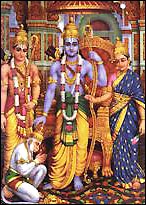Rama
|
|
This article is about a Hindu incarnation of God (i.e., Vishnu) and king of ancient India, for other meanings see Rama (disambiguation).
Srisita_ram_laxman_hanuman_manor.JPG
Rama (Rāma in IAST transliteration, राम in Sanskrit, sometimes referred to as Lord Rama and also as Shri Rama) is a Hindu incarnation of God, said to be one of the ten avatars of Vishnu. There is debate, existing mainly in the Western countries, as to whether he was a real or mythical king in ancient India. In Eastern countries, he is largely regarded as real. His life and heroic deeds are related in the Hindu Sanskrit epic the Ramayana. A great devotional work on him is the Ramcharitmanas by Tulsidas, which builds on the Hindu bhakti movements of devotion and love of God. Such benevolent movements are common in cultures centred around Hinduism.
The spelling and pronunciation of Rama follows the original Sanskrit; it continues to be followed in several modern languages of India. In modern Indian vernaculars, however, it is sometimes pronounced as 'Ram'.
Rama is the embodiment of the absolute - Brahman. There is debate to whether Shri Rama was aware of his own divinity during his years in human form. One purpose of his incarnation was to carry out leadership by example. He exemplifies the perfect man through his proper conduct regardless of the unfavorableness of circumstance.
Rama belonged to the Suryavansha (trans. Sun Dynasty, surya=sun, vansha=dynasty) and the Ikshvaku lineage. The Guru of the Suryavansha elders was Vashishta, the guru of Rama and his three brothers Lakshmana, Bharatha and Shatrughna was Vishwamitra.
Astronomical data in the Ramayana has been interpreted to suggest that his reign would have been at approximately 2015 BC. This makes little sense, however, given that Shri Rama assumed human form in the treta yuga (see yuga for more detail). It is known that the Ramayana was written before the other great Hindu epic, the Mahabharata, whose tradition of oral transmission is accepted to have existed around 1000 BC although there is little indication of when it actually begun (the writing coming much later). Thus, the Ramayana may have been documented anywhere from around 1500 BC to more conservative estimates of 500 BC. It should be noted that Indian culture has had a tradition of oral transmission of knowledge, considering it sacred and confidential. The Ramayana is a great literary work and piece of devotional and philosophical literature revered by both Hindus and individuals of other cultures.
In Hinduism, Rama is regarded as the seventh avatar of God, Vishnu and worshipped together with his wife Sita and devotee Hanuman.
He is the son of King Dasaratha and his queen Kausalya, making him a Prince of Ayodhya. At the instigation of Kaikeyi, another of his father's wives, he is banished to a forest. While in exile, his wife, Sita, is kidnapped by Ravana, King of the Rakshasas on Lanka. Rama, along with Hanuman, killed Ravana and rescued his wife Sita. The occasion of his victory over Ravana is celebrated every year by Hindus at Dassera (Vijaya Dashami, the day he won the battle according to the Hindu calendar). On Dassera, effigies of Ravana are burnt to commemorate the victory of good over evil. The burning of Ravana effigies symbolically represents burning the Ravana (the evil) within us. It also signifies the victory of dharma over adharma (which is similar to "good over evil" but not quite the same).
Rama also killed Vali, the King of Kishkinda. He rescued Ahalya, wife of great sage Gautama, after she was cursed by her husband for having an affair with Indra.
Lord Rama is seen as an ideal of Dharma and noble virtues. His wife, Sita, an incarnation of the Goddess Lakshmi - consort of Shri Vishnu, exemplifies the ideal wife.
| Hinduism | Dashavatara |
| Matsya | Kurma | Varaha | Narasimha | Vamana | Parashurama | Rama | Krishna | Balarama/Buddha | Kalki |
Template:Hindu Culture and Epicsde:Rama (Religion) fr:Râma ja:ラーマ jv:Rama ko:라마 (신화) nl:Rama pl:Rama (bóg) sv:Rama

